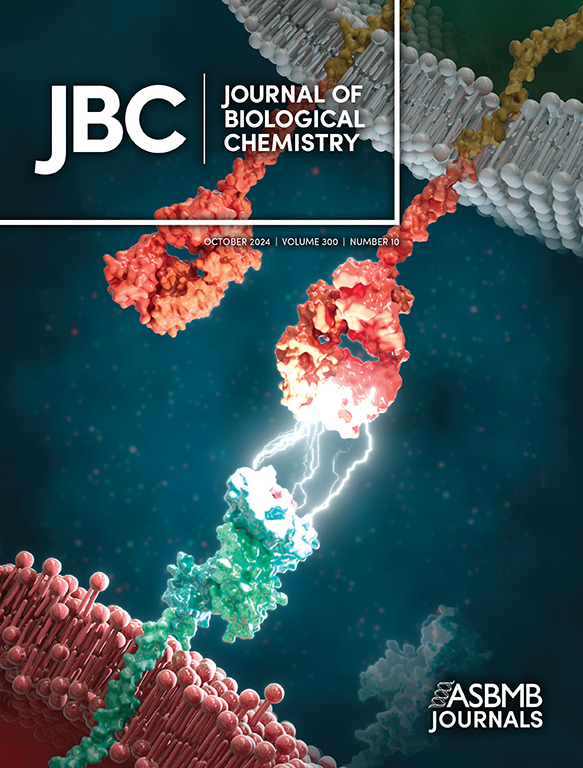缺氧可促进人冠状动脉内皮细胞生成富含多聚糖的细胞外基质。
IF 4
2区 生物学
Q2 BIOCHEMISTRY & MOLECULAR BIOLOGY
引用次数: 0
摘要
正常的内皮细胞(EC)功能对血管壁稳态至关重要,而功能障碍会增加心血管疾病的风险。低氧压(缺氧)促进EC功能障碍和动脉粥样硬化斑块的形成。越来越多的证据表明,缺氧驱动细胞外基质(ECM)重塑,这是动脉粥样硬化的一个既定因素。然而,缺氧对ECM和相关ECM蛋白的影响尚不清楚。本研究的目的是探讨在1% O2(缺氧)条件下培养人冠状动脉内皮细胞是否会改变这些细胞产生的ECM,以及这是否会影响HCAEC的功能。暴露于1% O2的hcaec导致缺氧反应(HIF-1α稳定)、功能障碍(氧化剂形成增加和eNOS降低)和炎症激活(IL-6和ICAM-1表达增加)。在1%和20% O2条件下培养7天的hcaec的蛋白质组学分析显示,缺氧诱导的细胞外蛋白发生了许多变化,尤其是细胞外蛋白聚糖(一种关键的ECM蛋白聚糖)的增加。在mRNA和蛋白质水平上证实了versican表达和沉积的增加,以及它的糖胺聚糖(硫酸软骨素)链,特别是6- o -硫酸酸化物种。这种富含versican的ECM显示透明质酸结合增加,细胞粘附性降低,但附着细胞增殖速度更快。在1% O2条件下,富含versican的ECM的产生提供了缺氧和动脉粥样硬化之间的联系,因为据报道versican在斑块中积累,在斑块中它结合并保留低密度脂蛋白,并参与炎症细胞的募集,从而增强低密度脂蛋白的修饰和脂质(泡沫)细胞的积累。本文章由计算机程序翻译,如有差异,请以英文原文为准。
Hypoxia promotes the generation of a versican-rich extracellular matrix by human coronary artery endothelial cells.
Normal endothelial cell (EC) function is essential for vascular wall homeostasis, whereas dysfunction increases the risk of cardiovascular disease. Low O2 tension (hypoxia) promotes EC dysfunction and the formation of atherosclerotic plaques. Increasing evidence suggests that hypoxia drives extracellular matrix (ECM) remodeling, an established contributing factor in atherosclerosis. However, the effects of hypoxia on ECs and associated ECM proteins are poorly understood. The aim of this study was to investigate whether the culture of human coronary artery ECs under 1% O2 (hypoxia) alters the ECM generated by these cells, and if this affects HCAEC function. Exposure of HCAECs to 1% O2 resulted in a hypoxic response (HIF-1α stabilization), dysfunction (increased oxidant formation and decreased eNOS), and inflammatory activation (increased IL-6 and ICAM-1 expression). Proteomic analysis of HCAECs cultured under 1% and 20% O2 for 7 days revealed many hypoxia-induced changes to extracellular proteins, particularly increased versican, a key ECM proteoglycan. Increased versican expression and deposition was confirmed at the mRNA and protein level, along with its glycosaminoglycan (chondroitin sulfate) chains and particularly 6-O-sulfated species. This versican-rich ECM showed increased hyaluronan binding and decreased cell adhesiveness, but attached cells proliferated at a greater rate. The generation of a versican-rich ECM under 1% O2 provides a link between hypoxia and atherosclerosis, since versican is reported to accumulate in plaques, where it binds and retains low-density lipoproteins and is involved in inflammatory cell recruitment, thereby potentiating low-density lipoprotein modification and the accumulation of lipid-laden (foam) cells.
求助全文
通过发布文献求助,成功后即可免费获取论文全文。
去求助
来源期刊

Journal of Biological Chemistry
Biochemistry, Genetics and Molecular Biology-Biochemistry
自引率
4.20%
发文量
1233
期刊介绍:
The Journal of Biological Chemistry welcomes high-quality science that seeks to elucidate the molecular and cellular basis of biological processes. Papers published in JBC can therefore fall under the umbrellas of not only biological chemistry, chemical biology, or biochemistry, but also allied disciplines such as biophysics, systems biology, RNA biology, immunology, microbiology, neurobiology, epigenetics, computational biology, ’omics, and many more. The outcome of our focus on papers that contribute novel and important mechanistic insights, rather than on a particular topic area, is that JBC is truly a melting pot for scientists across disciplines. In addition, JBC welcomes papers that describe methods that will help scientists push their biochemical inquiries forward and resources that will be of use to the research community.
 求助内容:
求助内容: 应助结果提醒方式:
应助结果提醒方式:


